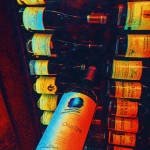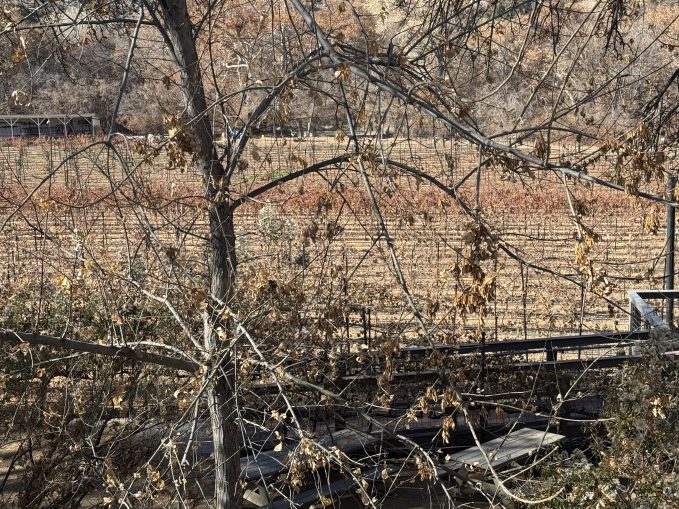
Darin Szilagyi
Wine X Magazine Online Edition
Not Just Cactus Juice Anymore
Arizona.
Say the name and most people picture red rock canyons, saguaro silhouettes, maybe a rusted-out pickup abandoned somewhere outside Sedona. No one thinks of Cabernet Sauvignon ripening at 5,000 feet. No one imagines Syrah fermented under the watchful eye of a winemaker who moonlights as a soil chemist. And they definitely don’t picture a wine culture with actual swagger. But they should.
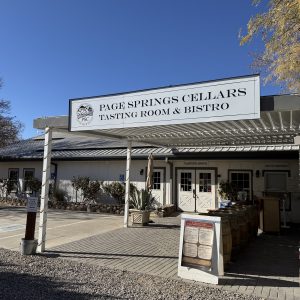 Because buried between the scorched clichés of golf courses and granola spiritual retreats is a growing, burning, absolutely feral wine movement that refuses to be cute or easy. This is not Wine Country™ with matching stemware and five o’clock shadows. This is Arizona: volcanic soils, blinding sun, vines clawing their way out of the desert floor. And somehow… it works.
Because buried between the scorched clichés of golf courses and granola spiritual retreats is a growing, burning, absolutely feral wine movement that refuses to be cute or easy. This is not Wine Country™ with matching stemware and five o’clock shadows. This is Arizona: volcanic soils, blinding sun, vines clawing their way out of the desert floor. And somehow… it works.
Arizona wine is no longer a punchline. It’s a punch — delivered with altitude, acid, and attitude. This is the story of that punch: who’s throwing it, what it tastes like, and why, if you’re still ignoring the Arizona wine scene, you might be drinking wrong.
Desert Terroir: What the Heck Is Happening Here?
Let’s start with the obvious: Arizona is a terrible idea for growing wine grapes. Too hot. Not enough water. Coyotes. Flash floods. Soil so dry it crumbles into dust when you sneeze near it. And yet, somehow, it’s becoming one of the most surprising, expressive, and unpredictable wine regions in America. Because here’s the thing — Arizona isn’t just a desert. It’s a high-altitude, multi-microclimate, volcanic-soil, sun-drenched rollercoaster of possibility.
Three AVAs and One Big “Prove It” Energy
Arizona has three official American Viticultural Areas (AVAs):
- Verde Valley AVA — North of Phoenix, near Sedona. Red rock country. Cooler climate. Home to Page Springs Cellars and a cluster of wine rebels.
- Willcox AVA — Southeast Arizona. High desert plains. Arizona’s powerhouse growing region, thanks to elevation (4,000–5,500 ft), loamy soils, and diurnal shifts that make Rhône grapes sing.
- Sonoita-Elgin AVA — South of Tucson. Arizona’s first AVA, established in 1984. Rolling grasslands, shallow rocky soils, and more altitude than attitude.
There’s also an unofficial fourth: whoever’s crazy enough to plant grapes outside of these zones. And in Arizona, there’s always someone trying something wild just beyond the AVA borders — because this state isn’t chasing tradition. It’s building its own.
Elevation Is the Secret Weapon
Think “desert,” and you probably imagine flat. Wrong. Much of Arizona wine country sits at 4,000–5,500 feet, making it one of the highest-elevation growing regions in North America. That altitude means:
- Cooler nights (big acid retention)
- Longer hang times (more flavor development)
- Lower disease pressure (fewer vineyard headaches)
Basically, you get the ripeness of Paso Robles with the balance of somewhere much cooler — all wrapped in a layer of volcanic and limestone-laced soil that makes wine geeks start twitching with excitement.
Sunburn, Monsoons, and Diurnal Whiplash
It’s not all romance, though. Arizona’s climate is ruthless.
- Summer heat can cook clusters if vineyard management isn’t on point.
- Monsoon season dumps inches of rain in a few hours — usually right before harvest.
- Hail, frost, and wind can blow through with the force of a rejected Tinder date.
So the people growing grapes here? They’re not hobbyists. They’re sun-scorched philosophers, adaptive farmers, and low-key masochists. And they’ve learned that the key to success isn’t fighting the chaos — it’s dancing with it.
Rhône to the Rescue (and Maybe Some Italian)
Not everything thrives here. Pinot Noir would rather die than grow in Arizona. Merlot struggles. Even Cabernet Sauvignon needs hand-holding and words of encouragement. But Rhône grapes? They’re having a moment.
- Syrah: Brooding, spicy, and unexpectedly elegant in the high desert.
- Grenache: Bright, lifted, and happy to play the long game.
- Mourvèdre: Thrives in the heat, adds structure, and makes winemakers swoon.
- Viognier, Roussanne, Marsanne: Texture bombs with altitude attitude.
Also quietly thriving? Italian varietals like Sangiovese, Malvasia Bianca, and Graciano, which have found a happy home in Willcox and Sonoita. Winemakers here aren’t shackled by expectation. They plant what they love, rip it out when it fails, and try again. It’s not a formula. It’s an evolution.
Water: The Literal Elephant in the Vineyard
Let’s not gloss over this: water is a problem in Arizona. For EVERYONE!
- Irrigation is essential for young vines.
- Rainfall is unreliable.
- The Colorado River is shrinking.
- Groundwater access is increasingly regulated.
Some winemakers are experimenting with dry farming, but most rely on smart irrigation and cover crops to keep vines alive. Sustainability isn’t just a buzzword here — it’s a survival strategy. Still, as climate change continues to wallop traditional wine regions, Arizona’s winemakers are already operating under pressure. And that might be their biggest advantage — they’ve been innovating under extreme conditions since day one.
The Soul of the State: Who’s Making It Happen
Arizona wine didn’t come from a marketing playbook. It wasn’t built by conglomerates in bespoke boots with Napa budgets and Napa consultants. It came from pioneers — experimentalists, biologists, metalheads, and madmen — who looked at volcanic rock, parched wind, and a 40°F diurnal swing and said, “Yeah, let’s grow grapes here.” The result? A wine culture with all the humility of the Rhône, the weirdness of Sonoma in the ’70s, and the creative grit of a garage band that just pressed their first vinyl. These are a few of the souls who made the Arizona wine scene not only possible, but cool.
Kent Callaghan — The OG Desert Romantic
You can’t talk Arizona wine without name-dropping Kent Callaghan, and if you don’t, someone else will — probably while pouring you one of his Sangiovese blends and staring wistfully into the Sonoita skyline. Callaghan Vineyards, established in 1990, is one of the oldest commercial vineyards in the state. Kent was there before AVAs, before buzz, before people believed you could do anything with grapes in Southern Arizona other than kill them with kindness and sunlight. His wines? Earthy, structured, and often unexpected. Callaghan’s blends (Cab-Syrah-Tempranillo love triangles) reflect the truth about Arizona: rules are for cowards. Kent never chased hype. He quietly built an empire of respect — and mentored the next wave of rebels in the process.
Todd Bostock — The Tinkerer’s Tinkerer
If Kent is the philosopher-poet of Arizona wine, then Todd Bostock is its caffeinated chemist. Winemaker for Dos Cabezas WineWorks, Todd’s fingerprints are all over the state’s rise. He’s a relentless experimenter — blending obscure varietals, tweaking fermentation temps, and treating yeast strains like Tinder swipes. His wines defy easy categorization. Tempranillo-Cab blends. Picpoul whites with acid for days. Skin-contact Viognier that slaps. And he’s not afraid of the screwcap. Todd is proof that Arizona’s soul doesn’t just come from the earth — it comes from people who won’t leave well enough alone.
Maynard James Keenan — The Rock Star Winemaker Who Actually Gives a Damn
Yes, that Maynard.
Yes, from Tool.
Yes, he’s legit.
It would’ve been easy for Maynard James Keenan to slap his name on a wine label, cash the checks, and call it a day. Instead, he built Caduceus Cellars and Merkin Vineyards — two fully functioning, often daring, absolutely rooted wine operations in Jerome and Cottonwood. He planted vines. Learned the science. Made mistakes. Pissed off purists. Then made them eat their words — ideally with a glass of his Nagual del Marzo. Keenan isn’t a novelty winemaker. He’s a boundary-breaking artist who treats wine like he treats music: as a medium for discomfort, beauty, and discovery. His visibility didn’t just help his own label — it put Arizona wine on the national radar. Period.
Kelly and Rob Hammelman — The Purists
You want elegance? Grace? Wine that makes sommeliers cry quiet tears of joy? Go drink something from Sand-Reckoner Vineyards, founded by Rob and Kelly Hammelman. Trained in Australia and fluent in finesse, Rob makes wines that prove Arizona can do subtlety — not just sun-baked swagger. His Malvasia Bianca is practically a state treasure, and his Nebbiolo could make Piedmont raise an eyebrow. They don’t shout. They don’t post. They just grow grapes, make killer wine, and remind us that Arizona doesn’t just do bold — it can do beautiful.
Grit, Vision, and Zero Templates
Here’s what these winemakers have in common:
- They had no roadmap.
- They said yes to failure.
- They leaned into the land instead of fighting it.
- And they made wine that actually tastes like where it came from — not where it wants to be sold.
They built Arizona’s wine culture the only way it could’ve been built: by refusing to imitate and insisting on figuring it out the hard way. This isn’t a scene dominated by billionaires or prestige chasers. It’s one run by dirt-stained dreamers who still hand-label bottles and argue about tannin structure over tacos. They’re not making wine to impress Paris or Napa. They’re making wine that matters here.
The Rise of the Next Wave
And now? There’s momentum.
Dozens of new producers are popping up across Willcox, Cornville, and the fringes. Women winemakers, Latinx vineyard crews, young soil scientists, and even a few chefs-turned-winemakers are adding depth and diversity to the scene. Tasting rooms no longer just exist for tourists. They’re cultural hubs — places where wine intersects with music, art, sustainability, and straight-up desert weirdness. And that’s exactly why people are starting to notice. Arizona isn’t trying to be the next California. It’s trying to be Arizona — and for the first time in a long time, that might be the smartest thing a wine region can do.
ARIDUS WINE COMPANY — Controlled Chaos and Barrel Swagger
“Aridus” is Latin for dry. It’s also Willcox’s best-dressed wine lab with a soul built on sun, science, and a maybe just a little controlled rebellion. If Page Springs is Arizona wine’s barefoot poet, then Aridus is its high-functioning alchemist — all stainless steel, industrial design, and mind-meld precision. It’s the winery that would be designed by a sommelier if they had an engineering degree and a penchant for low-key domination. And it’s rewriting the rules for what wine from Arizona — and desert wine in general — can taste like.
The Setting: Sleek, Silent, and Slightly Obsessed
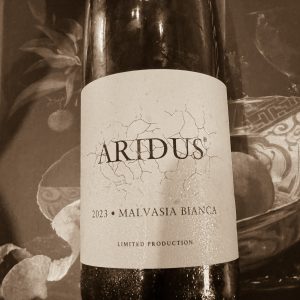 Driving into Willcox, Arizona, you don’t expect innovation. You expect old trucks, a few weathered storefronts, and maybe a great breakfast burrito. And then there’s Aridus — a modern winery that feels like someone airlifted it in from Scandinavia and then handed it a heat lamp. Glass, metal, clean lines, no-nonsense elegance. It’s not rustic. It’s not rustic-adjacent. It’s just unapologetically put-together, and it sets the tone for everything else that happens here. This isn’t just a winery. It’s a full-scale custom crush facility — one of the largest in Arizona — and it shows. There’s a seriousness here. A quiet hum of intention. Nothing feels accidental. Even the barrels look like they’ve been given performance reviews.
Driving into Willcox, Arizona, you don’t expect innovation. You expect old trucks, a few weathered storefronts, and maybe a great breakfast burrito. And then there’s Aridus — a modern winery that feels like someone airlifted it in from Scandinavia and then handed it a heat lamp. Glass, metal, clean lines, no-nonsense elegance. It’s not rustic. It’s not rustic-adjacent. It’s just unapologetically put-together, and it sets the tone for everything else that happens here. This isn’t just a winery. It’s a full-scale custom crush facility — one of the largest in Arizona — and it shows. There’s a seriousness here. A quiet hum of intention. Nothing feels accidental. Even the barrels look like they’ve been given performance reviews.
The Grapes: Local Roots, Global Ambition
Aridus sources grapes from both their estate vineyard in the Chiricahua Foothills and from a network of meticulously selected sites across Willcox AVA, Sonoita, and even New Mexico. If that makes your terroir radar twitch, good — because the story here isn’t about where the grapes come from. It’s about what’s done with them once they hit the crush pad. Owner and winemaker Lisa Strid is not messing around.
The Winemaking: Clean, Calm, and Always Calculated
Lisa doesn’t make wine like a mad scientist. She makes it like a pilot. Calm. Measured. Hyper-attentive. But never robotic. She’s the kind of winemaker who tracks fermentation temps like a hawk but still knows when to let the yeast run wild for the sake of flavor. And Aridus — as a facility — gives her the tools most winemakers in Arizona can only dream about:
- Temperature-controlled fermentation tanks
- Humidity-balanced barrel rooms
- In-house lab analysis
- Full-scale custom crush capabilities
It’s a winemaker’s playground. And Lisa? She’s swinging for the fences — but with grace.
The Wines: Altitude Attitude, Bottle by Bottle
Let’s talk juice. Aridus wines are structured. They’re food-driven, textural, and often surprisingly delicate given the heat they’re born into. There’s no gimmick here. Just glass after glass of oh damn, Arizona made this?
Aridus Graciano
Yes, Graciano — that dark, spicy grape usually playing third-string in Rioja blends. Lisa gives it the lead role, and it’s a stunner: blackberry, violets, a lick of black pepper. Balanced tannins, dusty finish. Tastes like a Spanish bullfight staged in the Chiricahua Mountains.
Malvasia Bianca
The wine that sneaks up on you. Aromatics go full tropical—guava, pineapple, white peach—but the finish is bone-dry and nervy. Think tiki party meets mineral meditation. We reviewed The Malvasia on our Instagram. Go, find it!
Petite Sirah
Dark, dense, and structured as hell, but never overripe. You could pour this blind and trick someone into thinking it’s from Paso… until that high desert acidity kicks in.
Tannat
This one hits like a kettlebell wrapped in velvet. Big tannins, yes, but a surprising lift — plum, graphite, roasted herbs. Proof that Arizona can do muscle without losing its necktie.
Chenin Blanc (if you can find it)
When it’s available, it’s magic: bright citrus, subtle waxiness, laser-like acidity. Loire Valley meets low desert. Only with more swagger.
The Philosophy: Minimal Intervention, Maximal Intention
Lisa doesn’t wave the “natural wine” flag — and thank god for that — but she believes in transparency, cleanliness, and staying out of the way when the fruit is good. She’ll cold soak when it helps. She’ll go native yeast when it feels right. She’ll fine and filter if the wine needs clarity. And she’s not afraid of sulfur — she’s afraid of flaws. Aridus wines reflect that balance. They’re not rustic. They’re refined — but still alive. Still desert-driven. Still a little wild under the surface. And that’s the whole point.
The Custom Crush Business: Behind the Scenes, Ahead of the Curve
Here’s the secret sauce most people don’t realize: Aridus isn’t just making their own wine — they’re helping others make theirs, too. Their custom crush program is one of the most sophisticated in the state, and it’s helping elevate the entire Arizona wine industry. Smaller producers bring in their grapes, rent space, use the equipment, and sometimes get guidance from Lisa and her team. It’s part business, part mentorship, and all about making sure Arizona wine doesn’t just grow — it grows well. You could argue that Aridus is as important to the Arizona wine ecosystem as the grapes themselves. They’re making the infrastructure possible — without ever sacrificing the artistry.
The Tasting Room: Yes, It’s Gorgeous
Of course it is. Located in downtown Willcox, Aridus’s tasting room is airy, modern, and tastefully industrial — like if Restoration Hardware had a wine-nerd cousin who went to architecture school.
- Concrete floors, reclaimed wood, pendant lighting.
- Clean branding, minimalist bottles, zero gimmick.
- Tasting flights served with just enough detail to make you smarter without making you feel small.
You’ll taste through five or six wines and walk out wondering why this place doesn’t have more hype. Then you’ll realize: the wine doesn’t need hype. It’s just good.
What Aridus Proves
You don’t have to be loud to be great.
You don’t have to be funky to be original.
And you don’t have to make “Arizona wine” taste like Arizona’s trying to be something else.
Aridus is showing what happens when you give a brilliant winemaker the tools to be precise — and then get out of the way. It’s modern desert winemaking at its best. Clean, intentional, endlessly drinkable — and still a little dangerous if you’re not paying attention.
PAGE SPRINGS CELLARS — Terroir-Driven Anarchy with a Hug
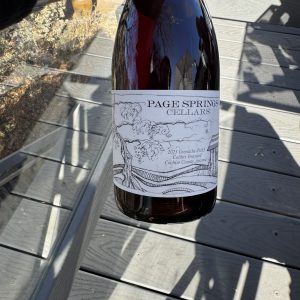 Where Rhône varietals roam wild, biodynamic principles flirt with moon phases, and the wine tastes like the earth sang it into being. There are wineries that make wine. Then there are wineries that make statements. Page Springs Cellars, tucked into the highland curves of Cornville, Arizona, doesn’t just pour wine. It pours philosophy, soil, sun, and just a touch of rebellion — all with a big grin and a splash of Viognier. If Aridus is the slick, tech-forward lab of Arizona wine, Page Springs is its shaman cave. Part spiritual center, part fermentation experiment, part backyard party with really, really good Syrah.
Where Rhône varietals roam wild, biodynamic principles flirt with moon phases, and the wine tastes like the earth sang it into being. There are wineries that make wine. Then there are wineries that make statements. Page Springs Cellars, tucked into the highland curves of Cornville, Arizona, doesn’t just pour wine. It pours philosophy, soil, sun, and just a touch of rebellion — all with a big grin and a splash of Viognier. If Aridus is the slick, tech-forward lab of Arizona wine, Page Springs is its shaman cave. Part spiritual center, part fermentation experiment, part backyard party with really, really good Syrah.
And at the center of it all? One man who makes it all tick.
Meet the Maverick: Eric Glomski
You don’t just tour Page Springs Cellars. You meet Eric Glomski — even if he’s not there. His fingerprints are everywhere. In the bottle. In the dirt. In the way every staff member talks about terroir like it’s a religion and a punchline at the same time. Glomski is a former biologist turned winemaker-philosopher. The kind of guy who can discuss riparian ecology, yeast behavior, and Biodynamic composting in the same sentence — and somehow make you want to drink more during all of it. His mission isn’t to make “great Arizona wine.” It’s to make wine that couldn’t have come from anywhere else.
The Location: Cornville (Yes, Really)
Page Springs Cellars sits just outside Sedona, in the Verde Valley AVA, a pocket of land known for its red rock drama, elevation swings, and hippie mysticism. It’s not textbook wine country — which is exactly why it works.
- Elevation: 3,300 to 3,800 feet
- Soils: volcanic, calcareous, and weirdly fertile
- Climate: monsoonal, hot days, cold nights
- Views: Ridiculous. Like “write a poem” ridiculous.
It’s the kind of place where Syrah thrives next to yoga mats. Where Mourvèdre sings to the coyotes. Where a concrete egg might be aging wine next to a Tibetan prayer flag. Welcome to high-desert wine country — where geology meets intention.
The Farming: Organic, Biodynamic, and Barefoot When Necessary
Page Springs doesn’t wear its farming practices like a badge. It wears them like skin. Everything starts with the soil — literally.
- No synthetic chemicals.
- Composting like religion.
- Moon cycles influence bottling schedules.
- Vineyard chickens. Yes, actual chickens.
- Hand-tending every vine — no mass mechanical harvesting.
It’s not about trendiness. It’s about energy — about respecting the land enough to grow with it instead of around it. Eric would say it better, probably while pouring you a cloudy barrel sample from a neutral oak puncheon he named Greg.
The Grapes: Rhône Rules, But It’s Not a Monarchy
Page Springs is a Rhône house at heart, but this isn’t a one-grape show. You’ll find Syrah, Grenache, Mourvèdre, Viognier, Roussanne, and Marsanne thriving here. But also rogue varietals like Petite Sirah, Cabernet Pfeffer, and even Tempranillo making cameo appearances. Every wine tells a story. Every story is rooted in place. No grape gets to be famous without proving it belongs in Arizona’s unforgiving dirt.
The Wines: Desert Soul in a Glass
Page Springs wines aren’t polished to death. They’re alive — textured, soulful, expressive. Sometimes wild. Sometimes restrained. Always honest.
House Mountain Syrah
Structured, deep, a little smoky — like a Rhône wine with a cowboy accent. Bramble fruit, cracked pepper, dried herbs. Finishes like a desert storm cooling down.
GSM Blends (El Serrano, Vino del Barrio Rojo)
Textbook Arizona: bold but not bloated. Red and black fruits, lively acidity, a little iron-rich earthiness. Tastes like a hike through the desert with a glass in hand and no need to go back.
Vino del Barrio Blanco
Fresh, floral, stone-fruit-driven. Porch wine with a philosophy degree. Roussanne leads, Viognier struts, Marsanne hums in the background. Clean but layered.
Colibri Syrah (limited release)
Grown at 5,200 feet — one of the highest elevation vineyards in North America. Intense and taut. Like licking a volcanic rock in the best way.
Vin de Table Series
Minimalist labels, maximalist expressions. Natural-ish. Unfiltered. Sometimes skin-contact whites, sometimes carbonic reds. All low-intervention, high-curiosity.
The Winemaking: Technique Meets Intuition
Eric’s background as a scientist shows up in the winery — but it’s never cold. This is natural wine made by someone who knows what he’s doing.
- Native ferments whenever possible
- Minimal sulfur
- A mix of concrete, stainless, and neutral oak
- Gentle extractions
- Lots of aging on lees
- A willingness to try anything that sounds insane
Glomski isn’t afraid to take risks, but he also hates flaws. So while the wines might feel wild, they’re always dialed in. It’s the difference between a jam band and a jazz quartet: both can improvise, but only one knows when to stop.
The Tasting Room: Rustic Magic Meets Wine Nerd Central
Step into the Page Springs tasting room, and you’re immediately greeted by the scent of barrels, lavender, and probably someone making sourdough in the back.
- Wood beams.
- Oversized leather chairs.
- Open decks overlooking the vineyard.
- Live music some nights, yoga on others.
- Staff that can talk skin contact or Carl Jung, depending on the vibe.
This is not a tasting room where you’ll be pressured into a wine club. This is a tasting room where you might accidentally stay all afternoon and leave with a bottle of Mourvèdre and a fresh perspective on life. Also: the house dogs are elite.
Beyond the Bottle: Wine as Ecosystem
Page Springs isn’t just a winery. It’s a fully immersive ecosystem:
- They make their own olive oil.
- Host community composting programs.
- Lead educational workshops on sustainability and viticulture.
- Pair with chefs for local, ingredient-driven tasting dinners.
- Serve as a hub for Arizona’s broader agricultural movement.
It’s a model of what the future of wine hospitality could be — communal, environmentally aware, and built around place rather than prestige.
The Vibe: Equal Parts Enlightenment and Punk Rock
You will not be bored here. You will not be coddled. You might be challenged. And that’s the point. Page Springs doesn’t care about scores or medals or what’s trending in the Loire. It cares about energy — in the vineyard, in the bottle, and in the people who drink it. It’s the rare winery that doesn’t just make wine — it makes connection. And it does it without ego.
What Page Springs Proves
Wine doesn’t have to come from tradition.
It doesn’t have to wear a tux.
It doesn’t have to be perfect.
It just has to taste like somewhere real — and someone real — brought it to life. Page Springs Cellars is messy in the right ways, precise in the ones that matter, and proof that desert wine can be more than viable — it can be transcendent.
The Road Ahead: Why Arizona Deserves a Seat at the Table
The Arizona wine scene is no longer just a curiosity. It’s a case study. A living, sunburnt, altitude-ripened example of what happens when you combine rogue ambition, real terroir, and an unshakable refusal to play by coastal rules. But let’s not get romantic too quickly — Arizona’s road ahead is still wild and uphill.
Perception Problems
Walk into most major wine shops outside the Southwest and ask for an Arizona bottle, and you’ll either get a blank stare or a polite redirect to “something from Paso.” The assumption is still that Arizona wine is novelty juice — too hot, too young, too rough. What those buyers are missing: a decade of evolution, and some of the most distinct Syrah and Rhône-style wines being made in the U.S. — at prices that won’t insult your rent.
Retail and Distribution Challenges
Getting Arizona wine into the national bloodstream is hard. Distribution laws suck. Shipping regulations are a mess. And Arizona winemakers, for all their grit, are often still selling direct-to-consumer or through regional shops and restaurants. But that’s starting to change.
- Sommeliers from L.A. to Chicago are starting to feature Arizona wines as offbeat gems.
- Wine competitions are handing out medals to blends from Willcox.
- More producers are working with marketing partners to scale storytelling and brand identity beyond the Arizona border.
And consumers? They’re finally starting to ask the right question:
“Wait… Arizona makes wine?”
Now the answer is: “Heck yes — and it’s probably better than that overpriced Pinot you keep pretending to like.”
Climate Change Is Real — and Arizona Is Already Adapted
Here’s the uncomfortable truth facing Napa, Sonoma, and most traditional wine regions: climate change is coming for your grapes. But Arizoa winemakers? They’ve been building around extreme heat and unpredictable weather from the jump. They’ve learned how to:
- Grow Rhône varietals that don’t blink at 100°F.
- Maximize irrigation in water-scarce environments.
- Farm at high elevations where diurnal swings preserve acid.
- Adapt winemaking practices to solar, wind, and monsoon chaos.
In other words, Arizona’s already doing what other regions are about to start figuring out.
That’s not just forward-thinking. That’s survival.
Sip the Desert, Rethink the Rules
Arizona wine isn’t about prestige. It’s about place. It doesn’t come with castle tours and Michelin-starred restaurant pairings. It comes with grit, wind, volcanic rock, and people who love the land so much they planted roots in it. And somehow, it works.
- It works in the Rhône-style elegance of Page Springs.
- It works in the stainless precision of Aridus.
- It works in the wild ferment funk of Sand-Reckoner, the bold ambition of Dos Cabezas, the rockstar winemaking of Caduceus, and the quiet mastery of Callaghan.
It works because Arizona wine doesn’t care what you expect. It only cares that when you take a sip — you stop. You pay attention. You wonder where this came from. You taste the dust, the heat, the wind, the experiment… and realize you’re drinking something that had to fight to exist. That’s what makes it special. That’s what makes it honest. That’s why Arizona isn’t just next. It’s now.
So go ahead. Drink something from Willcox. Order the Syrah from the Verde Valley. Sip the desert. Rethink the rules.
And when your friends raise an eyebrow? Just smile, raise your glass, and say:
“You’re welcome.”




